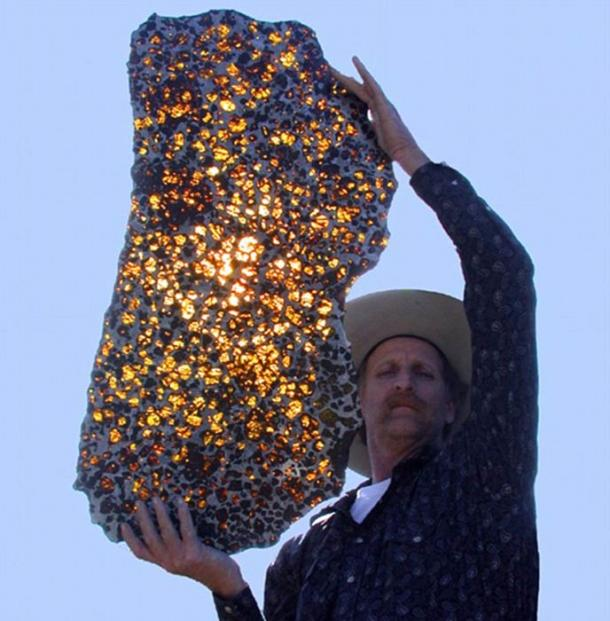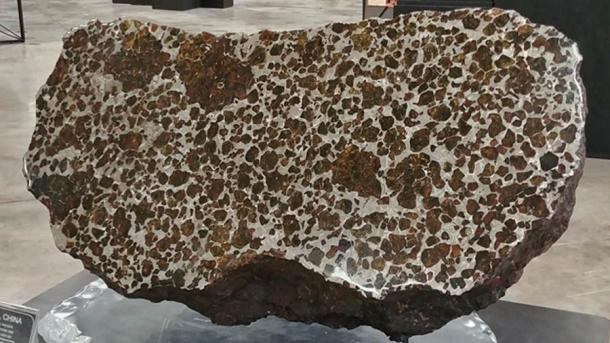
The Fukang Meteorite is the name given to a meteorite that was discovered in China. The Fukang Meteorite belongs to a class of stony-iron meteorite known as Pallasite, which may be recognized by the fragments of olivine crystals embedded in an iron-nickel matrix. According to one source, the stunning slices of such a meteorite, when illuminated from the back, are “reminiscent of stained glass windows crafted in the ancient solar system.”
Part of the Fukang Meteorite was recently sold at auction. In February 2021 Christie’s reports that it sold an “end wedge of the most beautiful extraterrestrial substance known.” Just that portion of the meteorite alone fetched a whopping 30,000 USD for the seller – well over the 3,500-4,500 USD estimate. So what makes the Fukang Meteorite so special?
For one thing, it’s not a “common meteorite.” Pallasites are an extremely rare type of meteorite. This is due to the fact that most Pallasites do not survive their descent through the Earth’s atmosphere. It has been estimated that less than 1 % of all meteorites are Pallasites. Therefore, the Fukang Meteorite has often been hailed as one of the greatest meteorite discoveries of the 21st century.

The Fukang Meteorite was discovered near the town of Fukang in Xinjiang, an autonomous region in the northwestern part of China. The meteorite was discovered in 2000 by an anonymous hiker. This hiker is said to have often stopped on a giant rock to have his lunch. He became curious about the type of rock, which seemed metallic and had crystals in it, that he had been resting on. The man decided to break some pieces of the rock off, and had them send to the United States, where it was confirmed that the sample he had sent was from a meteorite.

This is the main mass of the Fukang meteorite, on display in the Michael J. Drake building at the University of Arizona in Tucson. Note the large olivine nodules.
In February 2005, this specimen made an appearance at the Tucson Gem and Mineral Show, where it was seen by D. S. Lauretta, a Professor of Planetary Science and Cosmochemistry at the University of Arizona (and also the principal investigator of NASA’s OSIRIS-REx mission). Subsequently, the rest of the Fukang Meteorite (which has a mass of 983 kg (2167 lbs.), excluding the 20 kg (44 lbs.) removed by the anonymous hiker) was studied by the University of Arizona.

Fukang meteorite slice, pallasite. Exhibit at the Center for Meteorite Studies, Arizona State University, Tempe, Arizona, USA.
The Fukang Meteorite was found to be of a type of stony-iron meteorite known as Pallasite. Stony-iron meteorites are meteorites that are made up of meteoric iron and silicates in an almost equal proportion. Pallasites may be distinguished by a matrix of meteoric iron, in which silicates, mostly olivine (which is a type of yellow to yellowish-green crystal), are embedded. This type of meteorite, incidentally, is named after Simon Peter Pallas, a German doctor and naturalist who first described the Krasnojarsk Pallasite in Russia in 1772.
The exact origins of the Fukang Meteorite, as well as other Pallasites are not entirely clear. Nevertheless, it has been speculated that they originated from the boundary of a melted and differentiated asteroid and its surrounding olivine mantle. The Fukang Meteorite is thought to have been formed at the birth of the solar system approximately 4.5 billion years ago, when the olivine fragments from its mantle mixed with the molten metal from its core upon impact on earth.

Natural History Museum, Vienna. Part of a pallasite meteorite from Fukang
Due to this spectacular beauty, there has been a demand amongst collectors for slices of the Fukang Meteorite. The largest chunk of this meteorite, which weighs 419.5 kg (924.8 lbs.), is currently held by an anonymous collector / group of collectors. In 2008, an attempt was made to sell this portion of the Fukang Meteorite at an auction in Bonham’s in New York for about 2 million USD.
The object, however, did not receive any bidders. Other smaller slices of the meteorite, such as the aforementioned end wedge, have been sold at auctions and have been distributed around the world. The University of Arizona’s Southwest Meteorite Laboratory, for example, has a total of 31 kg (68 lbs.) of the Fukang Meteorite in its deposit.
https://www.ancient-origins.net/unexplained-phenomena/fukang-meteorite-007774

